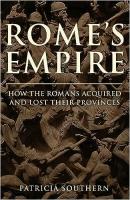
Amberley 2023 h/b 544pp £35 (ISBN 97814456943320)
S. is a prolific author of books and articles about Rome, its empire and its organisation, aimed at the general reader. In this volume she seeks to identify how Rome acquired, managed and finally lost the provinces which made up its Empire. For various administrative reasons her main narrative, which starts in 493 BC, ends in AD 408, but there is a final chapter which outlines more briefly what happened to individual provinces thereafter.
After a brief introduction, S. divides her narrative into 14 chapters taken in their historical order. Chapters 1 to 7 (225 pages) deal with the disorderly initial acquisitions up to the Augustan settlement; chapters 8 to 10 with the flowering of the system through to the Antonines (70 pages) and chapters 11 to 13 (70 pages) cover the empire’s gradual decline. Chapter 14 briefly outlines what happened afterwards. Within each chapter the story is frequently unfolded region by region. The text is supported by 16 rather uninspiring maps and a central group of 36 well explained illustrations. There are 36 pages of notes which mainly identify sources, and 18 pages of informative index. The 19-page bibliography includes the ancient sources and a range of modern sources mostly drawn from the past 40 years. Mommsen doesn’t make it but Syme just creeps in. It is not clear whether, in those relatively few instances where she identifies an academic source by name in the text, she is hinting that it will repay particular attention.
The presentation that S. adopts is muscular and free flowing with not a jargon phrase in sight. She provides a crisp, but thorough, precis of the ancient sources, records where they differ, but usually leaves the determination of probability to the reader (sometimes explicitly). She is basically non-judgemental, but an acerbic personal view is occasionally allowed to surface. She is more polite about Pompey than Caesar and gives Tacitus a touch of his own medicine. The span of material that she has to cover is immense and fact follows fact relentlessly. It can at times all seem a bit breathless.
This not a book for fellow academics—she explains that the Q in SPQR means ‘and’. It is inevitable in a book with such a density of detail that academic readers will encounter occasional factual inaccuracies and infelicitous descriptions which will irritate those who notice them. More important, perhaps, is how well S. serves her target audience, which I assume to be the general reader and particularly those studying classical civilisation at school or university. Her topic is an already well-tilled furrow for this constituency.
What is clear is that they receive a magisterial and encyclopaedic account of what happened in the provinces (or perhaps, more accurately, what the ancient sources say happened). She starts to make more use of epigraphical and archaeological material only in the later chapters. The result is that the story can appear to be that of an endless series of wars, atrocities and disasters with almost every character we meet dying either in battle or by execution or by assassination. Given this approach the book would benefit significantly from a greater number of and more informative maps—especially in the earlier chapters to identify the location of the targeted Latin communities and the vectors of the various campaigns.
They will perhaps get less help about the ‘how’ and the ‘why’. S. occasionally pauses from the flows of campaigning to reflect informatively for a few pages on foreign policy development or administration issues, notably at the Augustan settlement and at its Flavian revision. But for answers as to how the Romans managed to raise legion after legion, particularly in the early period; how the senatorial class managed to survive when so many of its active members appear to have been almost routinely killed off; how the provincials managed to acquire senatorial or equestrian status; how the civil service worked particularly when many emperors barely spent any time in Rome; and what was the effect of the eventual establishment of separate streams of promotion within the military and civil branches, the reader has to rely on occasional sentences which intersperse the military narrative. It would be easy for the reader to come away with the impression that war, civil mayhem and crisis dominated the empire at all times, unaware that for many years and in many provinces stability and some prosperity was the norm for most citizens.
In summary, this is a workmanlike, accessible, and comprehensive treatment of the topic it sets out to address and its student audience is likely to find it very useful. For the general CfA reader, it is perhaps too much of an encyclopaedia, though, as such, reasonably priced.
Roger Barnes
